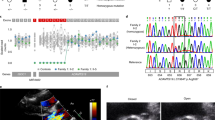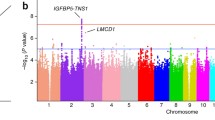Abstract
Marfan syndrome (MFS) is a systemic disorder of the connective tissue with pleiotropic manifestations due to heterozygous FBN1 mutations and consequent upregulation of TGFβ signaling in affected tissues. Myxomatous thickening and elongation of the mitral valve (MV) leaflets commonly occur in this condition. Investigation of murine models of this disease has led to improved understanding of the mechanisms that underlie many of the phenotypic features of MFS, including MV disease. Loeys–Dietz syndrome (LDS) is a related disorder due to heterozygous mutations in the genes encoding subunits of the TGFβ receptor, and it may also involve the MV leaflets with similar elongation and thickening of the MV leaflets. Although the genetic basis and pathogenesis of nonsyndromic MV prolapse has been elusive to date, insights derived from monogenic disorders like MFS and LDS can be informative with regard to novel gene discovery and investigation into the pathogenesis of MV disease. This manuscript will review the prevalence of MV disease in MFS, its pathogenic basis as determined in mice with Fbn1 mutations, and ongoing studies that seek to better understand MV disease in the context of fibrillin-1 deficiency or excessive TGFβ signaling.


Similar content being viewed by others
References
Marfan, A.-B. (1896). Un cas de deformation congenitale des quarte membres plus prononcee aux extremites caracterisee par l'allongement des os avec un certain degre d'amincissement. Bulletins et Mémoires de la Société Médicale des Hôpitaux de Paris, 13, 220–226.
Marfan, A.-B. (1938). La dolichosténomélie [dolichomélie arachnodactylie]. Annals of Medicine, 44, 5–29.
Baer, R. W., Taussig, H. B., & Oppenheimer, E. H. (1943). Congenital aneurysmal dilatation of the aorta associated with arachnodactyly. Bulletin of the Johns Hopkins Hospital, 72, 309–317.
McKusick, V. A. (1955). The cardiovascular aspects of Marfan's syndrome. Circulation, 11, 321.
Bowers, D. (1969). Pathogenesis of primary abnormalities of the mitral valve in Marfan's syndrome. British Heart Journal, 31, 679–683.
Loeys, B. L., Dietz, H. C., Braverman, A. C., et al. (2010). The revised Ghent nosology for the Marfan syndrome. Journal of Medical Genetics, 47, 476–485.
De Paepe, A., Devereux, R. B., Dietz, H. C., Hennekam, R. C., & Pyeritz, R. E. (1996). Revised diagnostic criteria for the Marfan syndrome. American Journal of Medical Genetics, 62, 417–426.
Barlow, J. B., & Bosman, C. K. (1966). Aneurysmal protrusion of the posterior leaflet of the mitral valve. An auscultatory-electrocardiographic syndrome. American Heart Journal, 71, 166–178.
Bhudia, S. K., Troughton, R., Lam, B. K., et al. (2006). Mitral valve surgery in the adult Marfan syndrome patient. The Annals of Thoracic Surgery, 81, 843–848.
Montgomery, R. A., Geraghty, M. T., Bull, E., et al. (1998). Multiple molecular mechanisms underlying subdiagnostic variants of Marfan syndrome. American Journal of Human Genetics, 63, 1703–1711.
Aalberts, J. J., Schuurman, A. G., Pals, G., et al. (2010). Recurrent and founder mutations in the Netherlands: extensive clinical variability in Marfan syndrome patients with a single novel recurrent fibrillin-1 missense mutation. Netherlands Heart Journal, 18, 85–89.
Pyeritz, R. E., & Wappel, M. A. (1983). Mitral valve dysfunction in the Marfan syndrome. Clinical and echocardiographic study of prevalence and natural history. The American Journal of Medicine, 74, 797–807.
Taub, C. C., Stoler, J. M., Perez-Sanz, T., et al. (2008). Mitral valve prolapse in Marfan syndrome: an old topic revisited. Echocardiography, 26(4), 357–364.
Detaint, D., Faivre, L., Collod-Beroud, G., et al. (2010). Cardiovascular manifestations in men and women carrying a FBN1 mutation. European Heart Journal, 31, 2223–2229.
Morse, R. P., Rockenmacher, S., Pyeritz, R. E., et al. (1990). Diagnosis and management of infantile Marfan syndrome. Pediatrics, 86, 888–895.
Sisk, H. E., Zahka, K. G., & Pyeritz, R. E. (1983). The Marfan syndrome in early childhood: analysis of 15 patients diagnosed at less than 4 years of age. The American Journal of Cardiology, 52, 353–358.
Faivre, L., Masurel-Paulet, A., Collod-Beroud, G., et al. (2009). Clinical and molecular study of 320 children with Marfan syndrome and related type I fibrillinopathies in a series of 1009 probands with pathogenic FBN1 mutations. Pediatrics, 123, 391–398.
Freed, L. A., Levy, D., Levine, R. A., et al. (1999). Prevalence and clinical outcome of mitral-valve prolapse. The New England Journal of Medicine, 341, 1–7.
Levine, R., Triulzi, M., Harrigan, P., & Weyman, A. (1987). The relationship of mitral annular shape to the diagnosis of mitral valve prolapse. Circulation, 75, 756–767.
Disse, S., Abergel, E., Berrebi, A., et al. (1999). Mapping of a first locus for autosomal dominant myxomatous mitral-valve prolapse to chromosome 16p11.2-p12.1. American Journal of Human Genetics, 65, 1242–1251.
Freed, L. A., Acierno, J. S., Jr., Dai, D., et al. (2003). A locus for autosomal dominant mitral valve prolapse on chromosome 11p15.4. American Journal of Human Genetics, 72, 1551–1559.
Nesta, F., Leyne, M., Yosefy, C., et al. (2005). New locus for autosomal dominant mitral valve prolapse on chromosome 13: clinical insights from genetic studies. Circulation, 112, 2022–2030.
Shi, Y., & Massague, J. (2003). Mechanisms of TGF-beta signaling from cell membrane to the nucleus. Cell, 113, 685–700.
Massam-Wu, T., Chiu, M., Choudhury, R., et al. (2010). Assembly of fibrillin microfibrils governs extracellular deposition of latent TGF beta. Journal of Cell Science, 123, 3006–3018.
Isogai, Z., Ono, R. N., Ushiro, S., et al. (2003). Latent transforming growth factor beta-binding protein 1 interacts with fibrillin and is a microfibril-associated protein. Journal of Biological Chemistry, 278, 2750–2757.
Judge, D. P., Biery, N. J., Keene, D. R., et al. (2004). Evidence for a critical contribution of haploinsufficiency in the complex pathogenesis of Marfan syndrome. The Journal of Clinical Investigation, 114, 172–181.
Ng, C. M., Cheng, A., Myers, L. A., et al. (2004). TGF-beta-dependent pathogenesis of mitral valve prolapse in a mouse model of Marfan syndrome. The Journal of Clinical Investigation, 114, 1586–1592.
Neptune, E. R., Frischmeyer, P. A., Arking, D. E., et al. (2003). Dysregulation of TGF-beta activation contributes to pathogenesis in Marfan syndrome. Nature Genetics, 33, 407–411.
Habashi, J. P., Judge, D. P., Holm, T. M., et al. (2006). Losartan, an AT1 antagonist, prevents aortic aneurysm in a mouse model of Marfan syndrome. Science, 312, 117–121.
Cohn, R. D., van Erp, C., Habashi, J. P., et al. (2007). Angiotensin II type 1 receptor blockade attenuates TGF-beta-induced failure of muscle regeneration in multiple myopathic states. Nature Medicine, 13, 204–210.
Jones, K. B., Myers, L., Judge, D. P., Kirby, P. A., Dietz, H. C., & Sponseller, P. D. (2005). Toward an understanding of dural ectasia: a light microscopy study in a murine model of Marfan syndrome. Spine, 30, 291–293.
Rodriguez-Vita, J., Sanchez-Lopez, E., Esteban, V., Ruperez, M., Egido, J., & Ruiz-Ortega, M. (2005). Angiotensin II activates the Smad pathway in vascular smooth muscle cells by a transforming growth factor-beta-independent mechanism. Circulation, 111, 2509–2517.
Lacro, R. V., Dietz, H. C., Wruck, L. M., et al. (2007). Rationale and design of a randomized clinical trial of beta-blocker therapy (atenolol) versus angiotensin II receptor blocker therapy (losartan) in individuals with Marfan syndrome. American Heart Journal, 154, 624–631.
Helin, K., Stoll, M., Meffert, S., Stroth, U., & Unger, T. (1997). The role of angiotensin receptors in cardiovascular diseases. Annals of Medicine, 29, 23–29.
Shafiq, M. M., Menon, D. V., & Victor, R. G. (2008). Oral direct renin inhibition: premise, promise, and potential limitations of a new antihypertensive drug. The American Journal of Medicine, 121, 265–271.
Pitt, B., Poole-Wilson, P. A., Segal, R., et al. (2000). Effect of losartan compared with captopril on mortality in patients with symptomatic heart failure: randomised trial—the Losartan Heart Failure Survival Study ELITE II. Lancet, 355, 1582–1587.
Barnett, A. H., Bain, S. C., Bouter, P., et al. (2004). Angiotensin-receptor blockade versus converting-enzyme inhibition in type 2 diabetes and nephropathy. The New England Journal of Medicine, 351, 1952–1961.
Jones, E. S., Black, M. J., & Widdop, R. E. (2004). Angiotensin AT2 receptor contributes to cardiovascular remodelling of aged rats during chronic AT1 receptor blockade. Journal of Molecular and Cellular Cardiology, 37, 1023–1030.
Daugherty, A., Manning, M. W., & Cassis, L. A. (2001). Antagonism of AT2 receptors augments angiotensin II-induced abdominal aortic aneurysms and atherosclerosis. British Journal of Pharmacology, 134, 865–870.
Nagashima, H., Sakomura, Y., Aoka, Y., et al. (2001). Angiotensin II type 2 receptor mediates vascular smooth muscle cell apoptosis in cystic medial degeneration associated with Marfan's syndrome. Circulation, 104, I282–I287.
Nagashima, H., Uto, K., Sakomura, Y., et al. (2002). An angiotensin-converting enzyme inhibitor, not an angiotensin II type-1 receptor blocker, prevents beta-aminopropionitrile monofumarate-induced aortic dissection in rats. Journal of Vascular Surgery, 36, 818–823.
Habashi, J. P., Doyle, J. J., Holm, T. M., et al. (2011). Angiotensin II type 2 receptor signaling attenuates aortic aneurysm in mice through ERK antagonism. Science, 332, 361–365.
Siragy, H. M., Inagami, T., Ichiki, T., & Carey, R. M. (1999). Sustained hypersensitivity to angiotensin II and its mechanism in mice lacking the subtype-2 (AT2) angiotensin receptor. Proceedings of the National Academy of Sciences of the United States of America, 96, 6506–6510.
Gu, X., & Masters, K. S. (2009). Role of the MAPK/ERK pathway in valvular interstitial cell calcification. American Journal of Physiology—Heart and Circulatory Physiology, 296, H1748–H1757.
Xu, J., Jian, B., Chu, R., et al. (2002). Serotonin mechanisms in heart valve disease II: the 5-HT2 receptor and its signaling pathway in aortic valve interstitial cells. American Journal of Pathology, 161, 2209–2218.
Loeys, B. L., Chen, J., Neptune, E. R., et al. (2005). A syndrome of altered cardiovascular, craniofacial, neurocognitive and skeletal development caused by mutations in TGFBR1 or TGFBR2. Nature Genetics, 37, 275–281.
Loeys, B. L., Schwarze, U., Holm, T., et al. (2006). Aneurysm syndromes caused by mutations in the TGF-beta receptor. The New England Journal of Medicine, 355, 788–798.
Attias, D., Stheneur, C., Roy, C., et al. (2009). Comparison of clinical presentations and outcomes between patients with TGFBR2 and FBN1 mutations in Marfan syndrome and related disorders. Circulation, 120, 2541–2549.
van de Laar, I. M., Oldenburg, R. A., Pals, G., et al. (2011). Mutations in SMAD3 cause a syndromic form of aortic aneurysms and dissections with early-onset osteoarthritis. Nature Genetics, 43, 121–126.
Acknowledgments
The authors gratefully acknowledge support from the Fondation Leducq, the W.W. Smith Charitable Trust, the Smilow Center for Marfan Syndrome Research, the National Marfan Foundation, the Howard Hughes Medical Institute, and the National Institutes of Health.
Author information
Authors and Affiliations
Corresponding author
Rights and permissions
About this article
Cite this article
Judge, D.P., Rouf, R., Habashi, J. et al. Mitral Valve Disease in Marfan Syndrome and Related Disorders. J. of Cardiovasc. Trans. Res. 4, 741–747 (2011). https://doi.org/10.1007/s12265-011-9314-y
Received:
Accepted:
Published:
Issue Date:
DOI: https://doi.org/10.1007/s12265-011-9314-y




